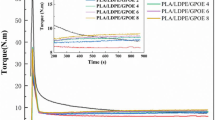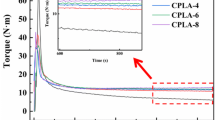Abstract
Poly(lactic acid) (PLA) foams have great potential for replacing synthetic polymer foams owing to their special properties such as biodegradability, biocompatibility and good mechanical performance. However, PLA has some drawbacks in common foaming processes to gain marketability. In this work, the PLA melt strength in extrusion foaming process was improved by adding different nanofillers, i.e. nanosilica, expanded graphite, pristine nanoclay and organoclay as well as chemicals including benzoyl peroxide and maleic anhydride grafted polyethylene. The morphological results and void content measurements show that the incorporation of the chemicals into PLA matrix comparatively causes better foam structural characteristics than nanofillers.
Access provided by Autonomous University of Puebla. Download conference paper PDF
Similar content being viewed by others
Keywords
1 Introduction
Recently, a lot of effort has been internationally made to obtain biodegradable polymers from renewable resources owing to the growing concern about the polymer wastes, fluctuating prices of petroleum and natural gas and severe depletion of fossil fuels [1]. One of these biopolymers that have been attracted a great interest is poly(lactic acid) (PLA). PLA foams have excellent potential to replace their non-biodegradable counterparts, polystyrene and polyethylene foams, due to the appropriate mechanical performance, accessible raw materials, comparative processing cost, biocompatibility and biodegradability [2]. However, PLA has several drawbacks in common foaming processes. Low melt strength of PLA as the main drawback can be overcome by using different methods such as applying PLA/nanoclay masterbatch in physical foaming process [3]. In this study, the melt strength of PLA in extrusion foaming process was improved by incorporating different nanofillers including nanosilica, expanded graphite, pristine nanoclay and organoclay along with different chemical reagents, a peroxide initiator and maleic anhydride grafted polymer, which has not been reported yet to the best of our knowledge.
2 Experimental
PLA (Ö5 BIOKAS) with melt flow rate of 7 g/10 min (210 °C, 2.16 kg) was supplied by Chemiekas GmbH. Hydrophobic nanosilica (Si) from Evonik Co., organically-modified nanoclay (ONC, Cloisite 15A) and unmodified nanoclay (UNC, Cloisite Na+) from Southern Clay Products Inc. and graphite powder after thermal expansion (EG, 104206) from Merck were used as nanoparticles in this work. Moreover, benzoyl peroxide (BP) from Merck and maleic anhydride-g-polyethylene (PEMA, Fusabond® E100) from Dupont as chemical reagents of PLA and azodicarbonamide (ADA) from Kum Yang Co. as chemical blowing agent were also applied. For preparing PLA chemical foams, first, PLA/nanofiller masterbatches containing each nanoparticle at 5 wt% loading were obtained using Rondol Microlab co-rotating twin-screw extruder at a temperature profile of 165 °C to 175 °C and screw speed of 150 rpm; second, the resultant masterbatches were pelletized and diluted by virgin PLA. Third, the physical mixtures of PLA and masterbatches were chemically foamed by incorporating ADA at fixed content of 4 phr through the twin-screw extruder with a slit die at a screw speed of 150 rpm and temperature profile of 165, 160, 170, 160, 150, 135, and 135 °C. The void content (Vf) of the prepared foams was determined by measuring the density of foamed and unfoamed samples with the same composition (except for ADA) and thermal history using solvent displacement method (ASTM D792). The foam morphology of the prepared films was observed by using HITACHS-4160 scanning electron microscopy (SEM) on the cryofractured and gold-sputtered surfaces. In the following parts, samples will be coded as PLAxY or PLAxYzW, where Y and W are the components incorporated into PLA and x and z are their weight fractions, respectively.
3 Results and Discussion
In the foaming extrusion process of PLA, the temperatures of slit die were chosen to be close to the PLA crystallization temperature, 135 °C, in order to improve the matrix melt strength. The SEM micrographs of the prepared PLA foams are illustrated in Fig. 1 and the foam void content along with the structural characteristics including number-average and volume-average cell diameter (Dn and Dv) and cell density are gathered in Table 1. The results show that by reducing the extruder screw speed to 75 rpm, the buddle size and void content increase and the cell density diminishes to lower values owing to higher residence time and intensified ADA decomposition and PLA hydrolysis. The addition of BP and PEMA has a considerable influence on the PLA foam morphology. While both of them results in larger cell density than virgin PLA, the BP incorporation causes smaller cells indicating the occurrence of chemical reaction between BP and PLA backbone and the resultant improvement in the PLA melt strength. Among the incorporated nanoparticles, Si and EG containing foams have higher void content, which stems from their stronger hydrophobic nature and interactions with PLA chains. On contrary, both nanoclays reduce the PLA void content, particularly organoclay, indicating their catalytic effect on PLA hydrolysis during extrusion process and correspondingly, the resultant poor melt strength [4]. However, an increment in ONC loading brings about smaller bubbles and larger cell density. The plausible reason is the cell nucleation-assisted effect of nanoparticles that is more pronounced at higher nanofiller loadings. The simultaneous addition of nanopaticles and PEMA results in smaller cells and cell density just for PLA1EG sample.
4 Conclusion
In this study, efforts were made to overcome the PLA drawbacks in the extrusion foaming process by adding different nanoparticles, i.e. nanosilica, pristine nanoclay, organoclay and expanded graphite, and chemical reagents including benzoyl proxide and PEMA. The findings show that the incorporation of chemicals such as the thermal initiator has more considerable effect on the PLA foaming process and foam morphology than the used nanoparticles.
References
Julien, H., Quantin, C., Benezet, J., Bergeret, A., et al.: Eur. Polym. J. 67, 40–49 (2015)
Nofar, M., Park, C.B.: Prog. Polym. Sci. 39, 1721–1741 (2014)
Nofar, M.: Mater. Des. 101, 24–34 (2016)
Fukushima, K., Abbate, C., Tabuani, D., Gennari, M.: Polym. Degrad. Stab. 94, 1646–1655 (2009)
Author information
Authors and Affiliations
Corresponding author
Editor information
Editors and Affiliations
Rights and permissions
Copyright information
© 2020 Springer Nature Switzerland AG
About this paper
Cite this paper
Khademi, MH., Ghavami, S., Hemmati, F., Aroon, MA. (2020). Extrusion Foaming of PLA-Based Nanocomposites: Effects of Different Nanofillers and Chemical Reagents on Foam Morphology. In: Mirzadeh, H., Katbab, A. (eds) Eco-friendly and Smart Polymer Systems. ISPST 2018. Springer, Cham. https://doi.org/10.1007/978-3-030-45085-4_68
Download citation
DOI: https://doi.org/10.1007/978-3-030-45085-4_68
Published:
Publisher Name: Springer, Cham
Print ISBN: 978-3-030-45084-7
Online ISBN: 978-3-030-45085-4
eBook Packages: Chemistry and Materials ScienceChemistry and Material Science (R0)





